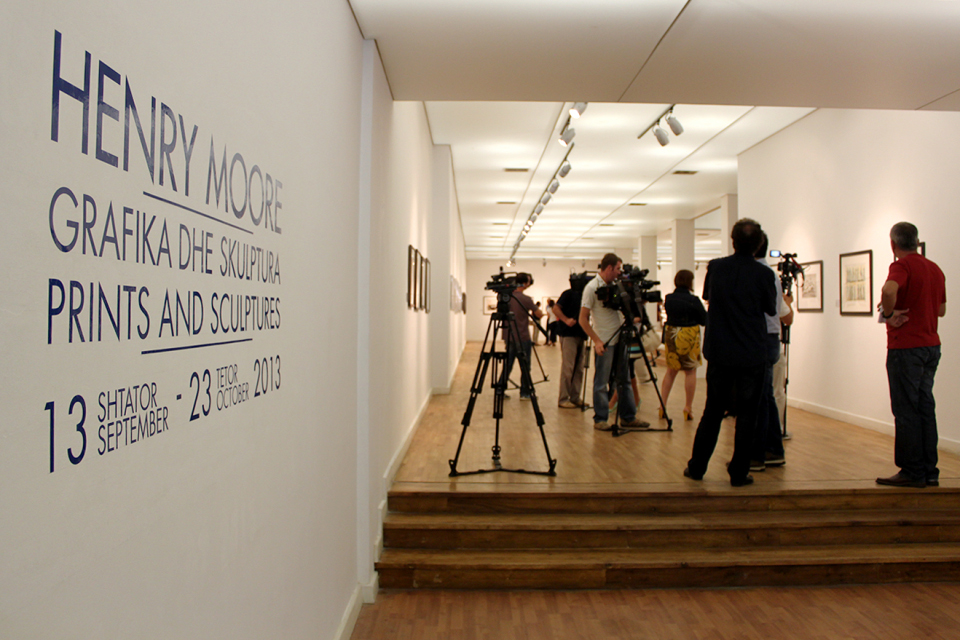Henry Moore. Prints and sculptures
British Ambassador Nicholas Cannon speech at the opening of Henry Moore exhibition in Tirana

It is a great privilege for me to open this exhibition of the work of Henry Moore, Britain’s greatest twentieth century sculptor. I would thank the National Arts Gallery for providing an excellent setting for the exhibition, and Vodafone for their support.

Henry Moore exhibition at the Gallery of Arts in Tirana
Henry Moore is an example of a great artist who came from very humble origins. His father was a coal miner in the mining town of Castleford in Yorkshire. Some critics believe that some of Moore’s work is inspired by the shapes of the Yorkshire hills. Henry Moore was the seventh of eight children in his family and grew up in conditions of great poverty. But his parents were devoted to ideals of education and encouraged him in his studies. At the age of eleven, he was inspired to became a sculptor after listening to a lecture on Michelangelo. In the First World War, he was the youngest man in his regiment, and Britain came close to losing one of its great artists when he was wounded in a gas attack.
Moore’s early work was shaped by four influences. The first was his childhood interest in medieval sculpture. The second was his close study of classical Italian sculpture. More unusually, Moore became interested in the sculpture of primitive societies such as the Aztecs and Maya, and their influence is apparent is many of his works. Fourthly, Moore’s studies in Paris brought him into contact with the modernist movement. Some of Moore’s works are of an abstract nature. Others focus on the themes of the reclining figure or of the mother and child. Psychologists might see in this the importance of Moore’s admiration for his mother, who as a typical Yorkshire women had worked hard in tough conditions to bring up a large family in an industrial town. Also Moore became a father late in life, at the age of forty-eight, after a happy marriage to a refugee from the Russian revolution

Henry Moore exhibition at the Gallery of Arts in Tirana
Early in his career, Moore experimented with the technique of direct carving, in which the marks of tools and imperfections in the material were considered an integral part of the art work. Later he moved on to casting figures in bronze, based on clay or plaster models. His interests were also explored in wood carvings, drawings and prints. He produced one work in brick, at the Bouwcentrum in Rotterdam: a giant sculpture made out of 16,000 bricks. Initially Moore’s work was considered controversial as it did not depict the human form in a realistic manner, but later his popularity grew in Britain, Europe and America. Moore stayed in London during the bombing raids of the Second World War in which his workshop was damaged. This experience inspired him to produce drawings of Londoners sheltering in bomb shelters in underground railways, and works that stressed themes of endurance and continuity. These themes made Moore popular as Britain was rebuilt after the destruction of the Second World War. Kenneth Clark, the Director of the National Gallery after the war, and a strong defender of the classical tradition, after initial criticism came to admire Moore’s work and promote his career. At the end of his life, Moore, a humble man with no interest in money or material wealth, bequeathed his fortune to establish a foundation to promote sculpture in the cultural life of Britain today.

Henry Moore exhibition at the Gallery of Arts in Tirana
Moore’s work remains highly regarded on the international art market. In 2012, two petty thieves stole a bronze Moore work from a museum near London. They took it to a scrap dealer and sold it to him for the price of the metal, forty-six pounds. The criminals were arrested and sentenced to one year’s imprisonment, and the statute returned to the museum. The thieves asked the judge how much the statute was worth and were astonished to be told it was worth half a million pounds.
Henry Moore’s first contact with the British Council was at the Venice Exhibition in 1948. So our Embassy and British Council colleagues are very proud to continue this tradition with this exhibition here in Tirana. I hope you enjoy the exhibition.